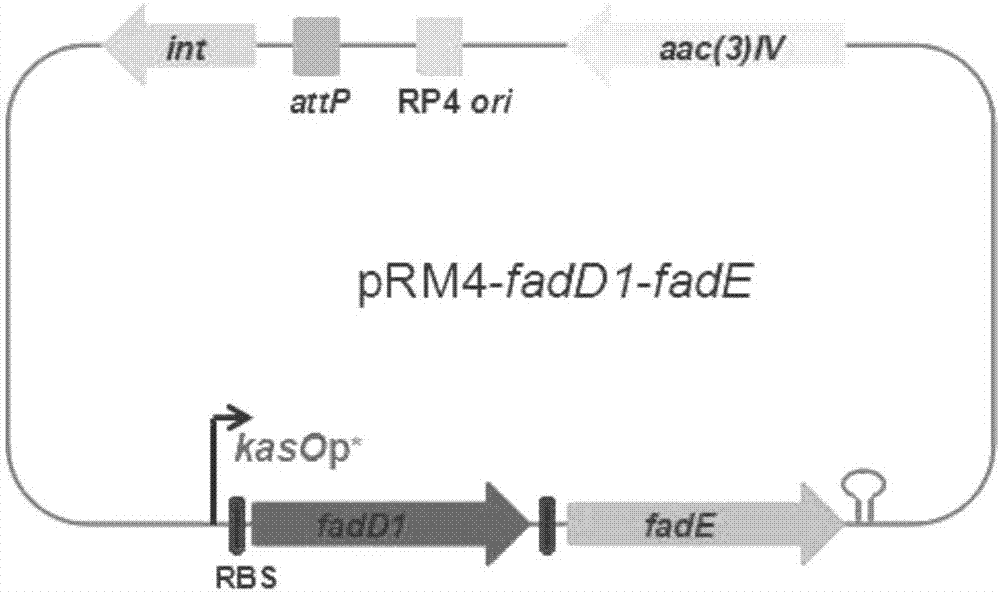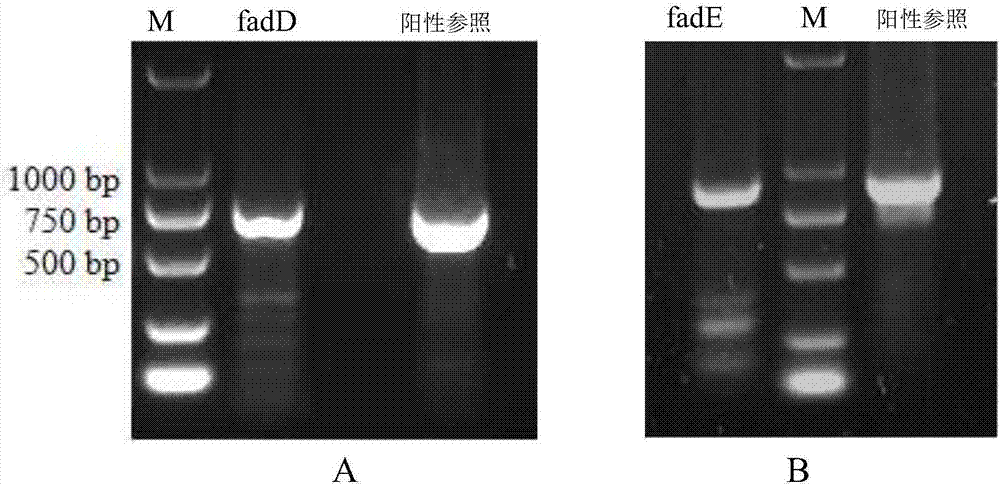Spinosad high-yield gene engineering bacterium and construction method and application thereof
A technology of genetically engineered bacteria and spinosyn, applied in the field of genetic engineering, can solve the problems of long cycle, heavy screening workload, and small yield fluctuation, and achieve the effects of increasing the yield and utilization of spinosyn
- Summary
- Abstract
- Description
- Claims
- Application Information
AI Technical Summary
Problems solved by technology
Method used
Image
Examples
Embodiment 1
[0041] Example 1 Construction of Saccharopolyspora spinosa Fatty Acid Metabolic Pathway Enhanced Strain
[0042] 1. Obtaining the starting strain
[0043] NTG and 60 Co alternate mutagenesis, the mutant strain of Saccharopolyspora spinosa obtained by mutagenesis, that is, the starting strain;
[0044] 2. PCR amplification of the coding gene fadD1 and fadE fragments of Streptomyces coelicolor acyl-CoA synthetase and acyl-CoA dehydrogenase
[0045] 2.1 Primer design
[0046] According to the DNA sequences of the coding regions of acyl-CoA synthetase (fadD1, GeneID: 1101636) and acyl-CoA dehydrogenase (fadE, GeneID: 1098484) involved in fatty acid metabolism in Streptomyces coelicolor, two pairs of primers were designed for respectively Amplify it. In the process of primer synthesis, the promoter kasOp* and RBS sequence were introduced into the upstream of the fadD1 fragment, and at the same time, the same RBS sequence was introduced upstream of the fadE coding frame fragment...
Embodiment 2
[0069] Example 2 Comparison of Shake Flask Fermentation of Fatty Acid Metabolic Pathway Enhanced Strains (Engineering Strains) and Starting Strains
[0070] 1. Shake flask fermentation of starting strains and engineering strains
[0071]Spread the Saccharopolyspora spinosa starting strain and the engineering strain spores on the solid medium (glucose 4g, yeast extract 10g, malt extract 10g, calcium carbonate 2g, agar 15g, deionized water supplemented to 1 liter). After culturing at 28°C for 168h, the spores were collected by hanging with 30% sterile glycerol to prepare a spore suspension, which was stored at -80°C for subsequent experiments.
[0072] Saccharopolyspora spinosa seed culture: Inoculate the Saccharopolyspora spinosa spore suspension at 1% in a 250mL Erlenmeyer flask with 30mL seed medium, and cultivate it for 45-48h at 28°C and 240rpm to obtain Saccharomyces spinosa Spore seed liquid. Among them, the seed medium is: 4g yeast extract, 4g peptone, 4g casein hydrol...
Embodiment 3
[0081] Example 3 The enhancement of the fatty acid metabolic pathway causes the change of the oxygen stress condition and then affects the production of spinosad
[0082] 1. During the fermentation process of engineering bacteria and starting bacteria, H 2 o 2 production testing
[0083] Reduced flavin dinucleotide (FADH) produced during β-oxidation of saturated and unsaturated fatty acids 2 ) amount is different, at the same time, fatty acyl-coenzyme dehydrogenase (FadE) and oxygen transfer flavoprotein are the organisms to form endogenous hydrogen peroxide (H 2 o 2 ) factor, while H 2 o 2 It also stimulates the secondary metabolism of actinomycetes. Therefore, for the H of the S. spinosa fermentation process 2 o 2 to test.
[0084] Such as Figure 4 As shown, in the case of no oil added, the H measured in the starting strain and the engineering strain 2 o 2 No difference, in case of added grease, H 2 o 2 Yield increased significantly. H 2 o 2 The amount was ...
PUM
 Login to View More
Login to View More Abstract
Description
Claims
Application Information
 Login to View More
Login to View More - R&D
- Intellectual Property
- Life Sciences
- Materials
- Tech Scout
- Unparalleled Data Quality
- Higher Quality Content
- 60% Fewer Hallucinations
Browse by: Latest US Patents, China's latest patents, Technical Efficacy Thesaurus, Application Domain, Technology Topic, Popular Technical Reports.
© 2025 PatSnap. All rights reserved.Legal|Privacy policy|Modern Slavery Act Transparency Statement|Sitemap|About US| Contact US: help@patsnap.com



